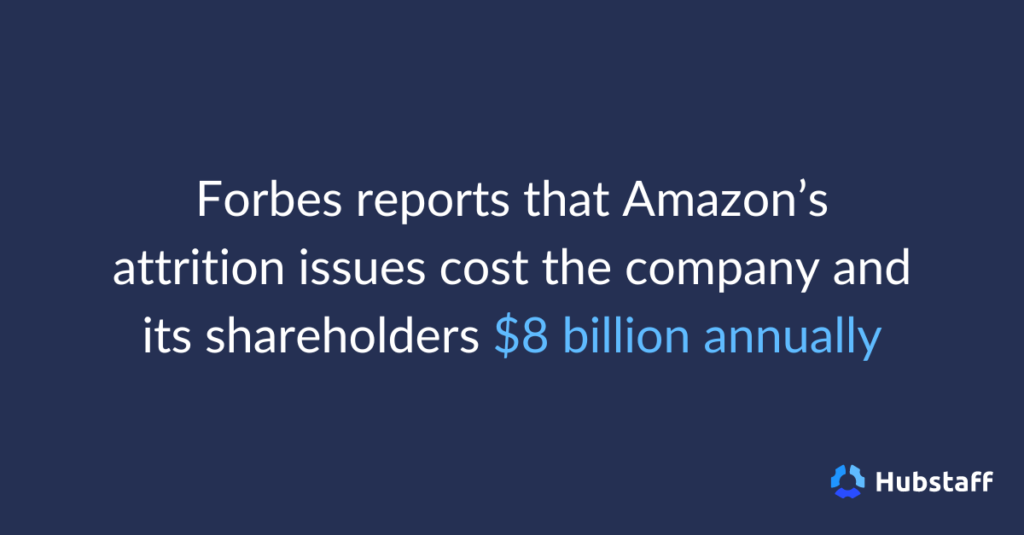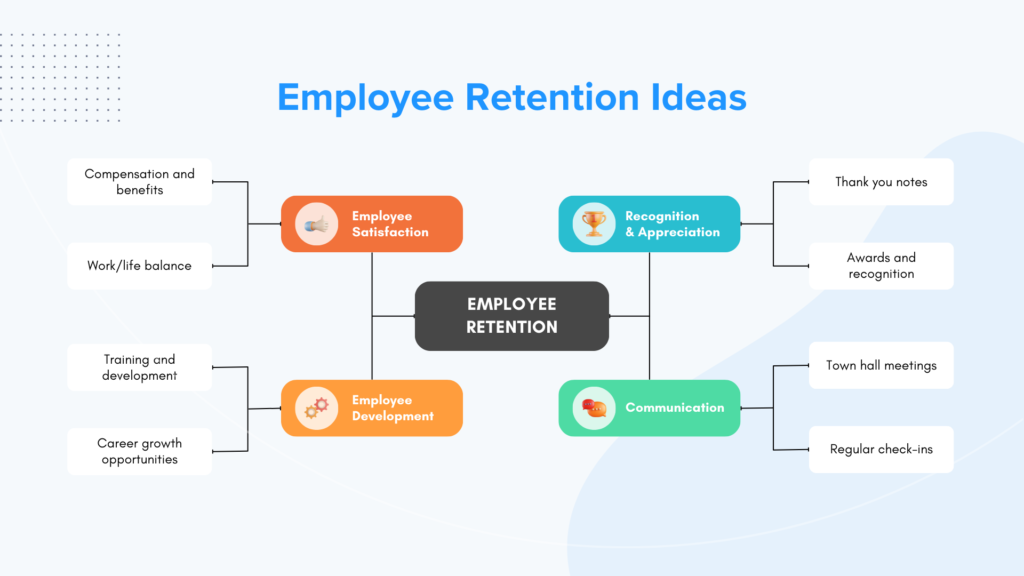Did you know turnover costs U.S. businesses upwards of $1 trillion annually? This stat alone should be reason enough for companies to prioritize learning how to retain workers.
In the cutthroat corporate world, we’ve all been taught that we’re replaceable — but is that still the case? Publications like Forbes are reporting a shrinking talent pool. A recent study found that for every 100 U.S. jobs, there are only 71 available workers.
Due to poor employee engagement and retention efforts, you can’t afford to add to a growing list of unfilled positions. With such a shortage of candidates, developing home-grown talent has become increasingly important.
That’s why, in this post, we’ll explore:
- The importance of employee retention
- Why employees leave jobs
- Strategies you can use to develop and retain employees
- How to measure retention efforts
Ready to learn more about employee retention? Let’s get started.
Boost your team’s efficiency with Hubstaff's productivity tools
The importance of employee retention
Employee retention is crucial for developing team chemistry, increasing productivity, and creating a general psychological safety in the workplace that keeps teams operating efficiently and effectively.
However, even for those who deny the importance of intangibles, employee retention is simply more profitable. Even the most profit-driven leaders can’t deny the effects of high employee turnover. Here are a few notable companies plagued by attrition issues:
- Forbes reports that Amazon’s attrition issues cost the company and its shareholders $8 billion annually.
- Salesforce’s attrition rate reached an all-time low of 7% in 2022. In May 2024, their stock price declined 20%, and they laid off over 1,000 employees in 2024 alone.
- Panera Bread’s seemingly impossible 100% turnover rate is par for the course. With 37,000 employees and the National Restaurant Association estimating $2,000 per employee in turnover losses, their annual attrition losses are roughly $74 million.
With so many negatives surrounding employee retention, let’s explore why employees leave and why companies struggle with this issue.

Understanding employee retention
By now, you fully grasp the financial ramifications of poor employee retention, but what about understanding employee retention as a whole? Let’s start with defining the term.
What is employee retention?
Employee retention is the act of preventing the number of employees that leave an organization due to voluntary or involuntary turnover. High employee retention rates are crucial for maintaining team chemistry, increasing efficiency, and limiting the costs associated with turnover.
Common reasons employees leave
Understanding employee retention and turnover is only part of the equation. To improve employee retention, you’ll need to uncover the reasons why employees leave like:
- Salary disagreements. Above all else, jobs are about getting paid. Compensation is the number one cause of employee turnover, with 55% of employees leaving for higher salaries elsewhere.
- Lack of opportunity for advancement. Most employees aren’t just looking for handouts to make more money. A survey from Apollo Technical found that 94% of employees would stay if their current company invested in their career development. If nothing else, it signifies better job security when companies invest in their employees.
- Burnout. Burnout has become a buzzword in recent years, but it’s a real problem directly correlated with high employee turnover. Burnout employees are 2.6 times more likely to leave their respective jobs.
- Poor DEI efforts. Nearly 80% of employees feel it’s essential to work for a company that prioritizes diversity, equity, and inclusion. Additionally, unconscious bias in the workplace costs U.S. businesses $550 billion each year.
- Micromanagement: Micromanagement has devastating effects on employee well-being, and 30% of employees quit due to poor management.
- Lack of flexibility. After the pandemic, return-to-office mandates saw 42% of companies experience higher-than-expected attrition. Switching to a hybrid work model has reduced quit rates by up to 33%.
Strategies to retain workers

Now that you’ve seen why employees leave jobs, it’s time to examine some employee retention strategies that address these issues.
- Competitive compensation and benefits. With over half of employees leaving for better salaries at other companies, a competitive compensation package is crucial. 78% of employees will stay with the company for an excellent benefits package.
- Career development and growth opportunities. We’ve also seen that career growth opportunities are crucial for improving retention rates. You can look to tools like Lattice, Hubstaff, and Officevibe for goal setting, virtual one-on-ones, performance review management, and more.
- Positive work environment. There are several ways to create a positive work environment for employees. Schedule team-building exercises, plan virtual retreats, and establish employee recognition channels to improve employee engagement.
- Work-life balance. Companies that provide a healthy work-life balance for employees experience 25% less turnover. Offer hybrid or remote work, flexible hours, and plenty of PTO to ensure employees are recharged.
- Engagement and inclusion. Implementing DEI and inclusion programs is not only objectively the right thing to do, but it also (to no one’s surprise) can positively impact employee retention.
Industry-specific retention strategies
With such a wide array of fields, finding a comprehensive employee retention program is hard. Instead, let’s look at how different fields address employee retention by looking at a few demographic and industry-specific strategies:
- Retaining healthcare workers. Healthcare retention strategies will center around a lot of the same touchpoints as any other strategy. However, one industry-specific way to retain healthcare workers is by optimizing scheduling.
- Retaining construction workers. While creating a psychologically safe work environment is the way to go for in-office work, you’ll also need to create a physically safe environment to retain construction workers. Safe environments reduce the risk of accidents and increase efficiency. Competitive benefits packages let your employees know you value their contributions and safety.
- Retaining older workers. A lot of content these days centers around catering to Gen Z and Millennial employees, who now make up most of the workplace. But what about older employees? Flexible working environments, competitive benefits, and 401K matching appeal to employees planning to retire in the coming years.
Creative ways to retain employees
To this point, most of our employee retention advice has focused on increasing compensation, providing better benefits, matching 401Ks, and other financial incentives. But what about some ways to retain employees when you’re on a budget?
Non-monetary incentives
As mentioned above, financial incentives are the ones that most directly impact employee retention — but that doesn’t mean all is lost if money is tight. Here are some examples of non-monetary incentives you can provide for your employees:
- Flexible work arrangements. Remote and hybrid work is becoming increasingly popular, but many businesses are still hesitant to adopt this model. 85% of employees found these models positively impacted employee well-being and, ultimately, retention.
- Asynchronous work. Asynchronous schedules allow teams to work outside of a conventional 9-to-5 schedule. This helps with increased productivity and around-the-clock coverage and makes sleepy heads like me quite happy.
- More PTO. Studies have shown that unlimited PTO programs are pretty popular with employees. They also don’t break the bank because, while they sound enticing, employees use significantly less PTO in these scenarios.
Employee recognition programs

While money motivates most people, positive words of affirmations go a long way as well. Recognized employees are 63% more likely to stay at their current jobs.
Creating rewards programs is a fun way to let employees know you’re prioritizing them without increasing spending. Winners of team-building events could benefit from additional PTO, WFH days, company swag, and other more affordable rewards.
Measuring and improving retention efforts
Like any other metric, you can’t improve retention if you’re not tracking it correctly. With the right tools, you can monitor retention metrics and make changes before turnover takes hold of your business.
Monitoring retention metrics
Here are a few of the critical employee retention metrics that businesses use to reduce turnover:
- Overall turnover rate. The overall turnover rate is an HR metric that calculates the rate at which employees move on from the company — whether voluntarily or involuntarily.
- Voluntary turnover rate. The voluntary turnover rate is similar to the overall turnover rate, but it only accounts for those who leave on their own terms. Examples may include voluntary resignation, taking a new job, or retirement.
- Involuntary turnover rate. Involuntary turnover rates take firings and other employer-initiated separations between employees and employers.
- Employee satisfaction. Employee satisfaction sounds like an intangible, but there are ways to quantify it. Employee feedback scores and anonymous surveys are just a few ways to find numeric value for employee job satisfaction.
Continuous improvement
Mastering employee retention is an ongoing, uphill battle of continuous improvement. What works this year may not work next year. It is essential to create a culture of trust and transparency where employees can openly discuss their needs.
In other words, blog posts, webinars, videos, and other media can help you gauge what ideas might work. Still, the only way to improve employee retention is to talk with your employees and learn what motivates them to stay with your company. From there, you can iterate on their input and create effective employee retention strategies that work year-over-year.
Turnover a new leaf
Now that you’ve learned about some causes, strategies, and metrics associated with employee retention, it’s time to connect with your team and find out what factors matter most. From there, you can create an employee-led retention strategy that puts your employees’ needs at the forefront.
Do you have any ideas we didn’t cover that aided your team in employee retention? We’d love to hear from you.
Frequently asked questions for how to retain workers
How do you improve staff retention?
There are several ways to improve retention, such as:
- Competitive compensation and benefits
- Career development and growth opportunities
- Positive work environment
- Work-life balance
- Engagement and inclusion
Beyond these methods, it’s also essential to use the right employee productivity tools that emphasize employee mental health and well-being when creating key retention strategies.
What are the best employee retention strategies?
There are countless ways to boost employee retention, but the best employee retention strategy you can create usually involves:
- Create an onboarding process that sets employees up for long-term success
- Reassess compensation
- Provide competitive benefits packages
- Create professional development opportunities for raises and promotions
- Prioritize DEI efforts, healthy work-life balance, and other initiatives
- Offer mentorship opportunities to help employees and managers grow
How can you retain staff without increasing salaries?
While salary increases are the number one reason employees leave their current company, they’re not the be-all and end-all of employee retention. You’ll likely see your retention numbers improve by creating career development programs, offering mentorship opportunities, building an inclusive work environment, and emphasizing employee mental health and well-being.
Most popular
The Fundamentals of Employee Goal Setting
Employee goal setting is crucial for reaching broader business goals, but a lot of us struggle to know where to start. American...
Data-Driven Productivity with Hubstaff Insights: Webinar Recap
In our recent webinar, the product team provided a deep overview of the Hubstaff Insights add-on, a powerful productivity measurem...
The Critical Role of Employee Monitoring and Workplace Security
Why do we need employee monitoring and workplace security? Companies had to adapt fast when the world shifted to remote work...
15 Ways to Use AI in the Workforce
Whether through AI-powered project management, strategic planning, or simply automating simple admin work, we’ve seen a dramatic...




